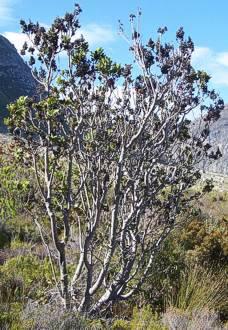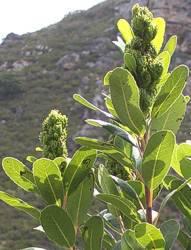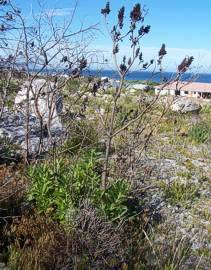Laurophyllus capensis
Laurophyllus capensis Thunb.
Family: Anacardiaceae
Common names: iron martin (Eng.); ystermartiens, filabos(sie), vlakwitels (Afr.)
SA Tree No: 366
Introduction
Reindeer antlers on an African tree? Endemic to the Western and Eastern Cape, the iron martin has separate male and female trees. The female trees carry unusual woody flowering structures, formed by bracts, that remain on the tree long after the flowers and seeds have disappeared. These resemble bunches of closely packed deer antlers along the terminal branches of the tree.

Description
Description
Laurophyllus capensis is an evergreen shrub or small shrubby tree up to 6 m, with erect branches. The leathery, strongly serrated elliptic leaves are simple, deep to dark green, glossy on the upper surface and paler beneath, 60-140 mm long, arranged alternately along the branches and exude a sticky, brown, resinous juice when crushed.

The white or yellow flowers are very small, made up in four to five floral parts and appear from August to January. The flowers on the male tree occur in lax terminal sprays, whereas on the female tree the flowers are borne in strangely branched flower heads, also at the ends of branches. Some people mistakenly think that these are deformities caused by a parasite. The male flowers have no ovaries and there are no stamens in the female flowers.

The fruit is a small, flattened, single-seeded nutlet, about 4-5 mm in diameter, with a slight wing, and is packed tightly into the woody female flowering structure. It starts off green and matures to a rich brown, then finally weathers to a silvery grey after a year or two.

Distribution and habitat
Distribution description
Laurophyllus capensis is endemic to the Western and Eastern Cape from Uitenhage in the east to Betty's Bay in the west. It occurs along stream banks and wooded slopes, and forms part of the scrub and scrub forest or forest margins together with other small trees in damp to wet areas. At the western end of its distribution range, rainfall occurs in winter, but towards the east, especially in the Tsitsikamma portion of its range, rainfall occurs throughout the year.
Derivation of name and historical aspects
History
The old scientific name for this tree was Botryceras laurinum, which was actually a very good description for the flowering branches of the female tree as botryceras means clustered horns. This refers to the strange, compact, woody branches holding the female flowers and later the seeds. However, the current scientific name is also descriptive in that the generic name Laurophyllus is based on the Latin word lauro and the Greek word phyllus, which translates to laurel leaf, as the leaves are similar to those of the laurel tree known around the Mediterranean sea. The Latin species name capensis means of the Cape, referring to its habitat. Swedish botanist, Carl Thunberg, discovered it in 1772 in the Outeniqua Mountains.
The English and Afrikaans common names, iron martin and ystermartiens, pay tribute to the toughness displayed by the plant in persistently resprouting after veld fires. Filabossie is a corruption of the Afrikaans name vlakbossie, derived from vlakwitels, as the plant often grows in waterlogged flats (vlaktes in Afrikaans). The shape of the leaf is similar to a single leaflet of Platylophus trifoliatus, commonly known as the witels which also grows in the same area.
The family to which this plant belongs is the Anacardiaceae, which is chiefly tropical, although some species occur in Mediterranean climates. It is commonly known as the mango or cashew family which contains about 60 genera and about 600 species altogether. Other well-known members in this family are the pistachio nut, Pistacia vera, and the marula, Sclerocarya birrea.
The genus Laurophyllus is monospecific, i.e. it comprises only one species, capensis. There are other monospecific genera in this family in South Africa including Smodingium argutum (African poison oak/ pynbos), Heeria argentea (rockwood/ kliphout), Harpephyllum caffrum (wild plum) and Loxostylis alata (tierhout).
Ecology
Ecology
It would appear that the plants may be long-lived as they quickly resprout after fires or if they have been cut back. Plants which were burnt in a fire in the Betty's Bay area in January 2008 had sprouted shoots up to 0.8 m by April 2009. Plants on a roadside verge in the Kogelberg Nature Reserve had produced shoots of 1.4 m three years after being severely cut back.

When clear-felling was still practised in the forests of eastern Tsistikamma, it often resulted in the development of dense, scrub communities of iron martin.
Pollinators for the species are so far unknown. The shape of the fruit indicates that it is wind-dispersed. Not all seeds are released at once, due to the clasping incurved branches of the female inflorescence. When collecting seed, a louse-like insect was discovered hiding among the seeds but it was not known if this creature was feeding on the seed or perhaps laying eggs on it. The old inflorescence branches remain on the female plants until they are weathered away, broken off, or burnt off during fires.
Uses
Use
No uses have been recorded although the author has used the female branches with their antler-like bracts in dried flower arrangements, and has broken off smaller pieces and glued them to decorative wreaths.
Growing Laurophyllus capensis
Grow
Attempts to germinate seed and to grow this plant at Harold Porter NBG have not been successful and it remains a challenge.
References
- Coates Palgrave, K. 1983. Trees of southern Africa. Struik, Cape Town.
- Germishuizen, G., Meyer, N.L., Steenkamp, Y. & Keith, M. (eds). 2006. A checklist of South African plants. Southern African Botanical Diversity Network Report No. 41. SABONET, Pretoria.
- Goldblatt, P. & Manning, J. 2000. Cape plants. A conspectus of the Cape flora of South Africa. Strelitzia 9. National Botanical Institute, Cape Town & Missouri Botanical Garden.
- Leistner, O.A. (ed.). 2000. Seed plants of southern Africa : families and genera. Strelitzia 10. National Botanical Institute, Pretoria.
- Palmer, E. & Pitman, N. 1972. Trees of southern Africa, vol. 2. Balkema, Cape Town.
- Rycroft, H.B. 1980. Trees of the Tsitsikama National Parks. National Parks Board of Trustees of the Republic of South Africa.
- Smith, C.A. 1966. Common names of South African plants. Memoirs of the Botanical Survey of South Africa No. 35.
- Von Breitenbach, F. 1974. Southern Cape forests and trees. The Government Printer, Pretoria.
- Von Breitenbach, F. 1986. National List of indigenous trees. Dendrological Foundation, Pretoria.
Credits
Jane Forrester
Harold Porter National Botanical Garden
May 2009
Plant Attributes:
Plant Type: Shrub, Tree
SA Distribution: Eastern Cape, Western Cape
Soil type: Sandy
Flowering season: Spring, Early Summer
PH:
Flower colour: White, Yellow
Aspect: Full Sun
Gardening skill: Challenging
Special Features:
Horticultural zones








Rate this article
Article well written and informative
Rate this plant
Is this an interesting plant?
Login to add your Comment
Back to topNot registered yet? Click here to register.